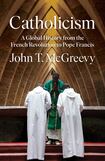
The theme of John McGreevy’s wonderful new study of global Catholicism from the French Revolution of 1789 until the present day is the tension between the promise of “progress” inherent in the development of the modern world, and “tradition” as embodied by the teachings and practices of the institutional Catholic Church.
He is especially interested in people who acted as interlocutors between these countervailing forces, especially Catholic thinkers. The French reformist Jacques Maritain features prominently along with Edith Stein, the German Jewish convert who was murdered in the gas chambers at Auschwitz in 1942, and Gustavo Gutiérrez, the Peruvian priest who was one of the founders of liberation theology.
One of the book’s many strengths is the confidence to range across the world from Latin America to sub-Saharan Africa. Intellectually this would be a challenge for any historian, though McGreevy effortlessly guides us with a steady hand through this complex history over the last two centuries and more.
There is much of interest for Irish readers throughout the book. When King Louis XVI was executed in Paris on January 21st, 1793, the last person to speak to him, kneeling down just before Louis was executed by guillotine, was an Irish-born priest, Abbé Henry Edgeworth. Edgeworth, from Co Longford, was a distant cousin of the famous writer Maria Edgeworth. Henry’s father had converted to Catholicism in the late 1740s and his young son joined the priesthood after the family moved to France. He was a vocal critic of the French revolution and spent a couple of years avoiding the French authorities, eventually dying in Russia in 1807.
Forget the gym: Here’s four fitness lessons from around the world
An Irishman at Oxford: It was an education in being an outsider. I felt alienated from the very start
My brother Ian Bailey: ‘He pleaded his case and begged me to keep in touch, and I did’
Diary of a retrofit: It cost €60,000 but it is worth every cent
The final chapter of this wide-ranging and stimulating history discusses the clerical sexual abuse of children and the attempts to cover this up by church authorities around the world. The account opens in Ballarat, the city about 70 miles from Melbourne, where Irish Catholic priests ministered in this gold rush town in the 19th century. As the Australian Royal Commission on Institutional Responses to Child Sex documented, both the Christian Brothers and diocesan clergy in Ballarat were involved in the systematic sexual abuse of children, particularly young boys, over a long period of time.
The response to anyone who raised the sexual abuse of children by Catholic clergy is the familiar one of the complete denial of survivors’ testimonies, protection of perpetrators, evasion, lies and cover-ups. McGreevy notes that “protecting priests and the church’s reputation, instead of acknowledging the pain and suffering of survivors, was usually paramount” and this was certainly the case in Ireland from the 1990s onwards. The damage done to the authority of the Catholic Church in Ireland as elsewhere was incalculable.
Other events that shed light on the darker history of the Catholic Church are covered including the long-standing anti-Semitism of some Catholic figures, including an Irish Holy Ghost priest, Fr Denis Fahey, whose views were widely publicised in the late 1930s by the famous American anti-Semite radio priest, Fr Charles E Coughlin. The controversy about the public silence of Pope Pius XII during the Holocaust is also explored in an even-handed way.
At one time being Irish was synonymous with being a Catholic. How much things have changed since the days of the early 1970s when more than 90 per cent of Irish Catholics reported that they attended Mass at least weekly. Recent estimates suggest that the figure is now nearer to 30 per cent. Such is the extent of the transformation in the last half-century, both North and South, that the world of the 1970s bears very few resemblances to Ireland today. Most people welcomed these changes.
The debates from the 1970s onwards about same-sex marriage, LGBT rights, abortion, contraception, the role of women within the church, and the celibacy of priests are rightly given a prominent role in this story as well as the absolute refusal of church authorities to move away from traditionalist positions, all with strong Irish echoes.
McGreevy’s excellent history of global Catholicism concludes on a positive note with Pope Francis’s attempts to listen to dissenting voices on issues such as divorced Catholics receiving communion and the question of married clergy. Given the strength of conservative forces within the church, whether any substantive change will occur is without doubt another matter.
Though McGreevy does not directly say this, there is a sense across the whole book that the Catholic Church was far too reluctant to engage with questions about the nature and effects of global capitalism, preferring this economic system with its intrinsic inequalities over the frightening alternative of socialism or, worst of all, communism. One figure who stands out is Dom Hélder Cámara, the Brazilian socialist archbishop who was a constant critic of the military dictatorship in Brazil in the 1960s and 1970s — one government official dubbed him “Fidel Castro in a cassock”.
- Enda Delaney is Professor of Modern History at the University of Edinburgh











